SUMMARY
This is AI generated summarization, which may have errors. For context, always refer to the full article.
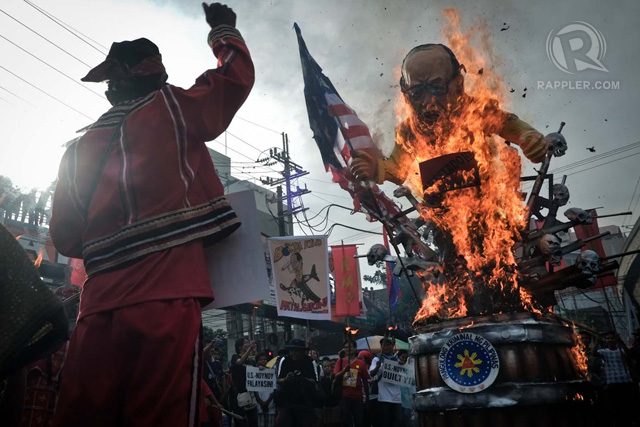
MANILA, Philippines — A pig, a dog, and a war machine. These are among the ways militant groups portrayed President Benigno Aquino III in their protest actions in 2014.
During the International Women’s Day rally, a life-size figure of Aquino was even dragged by a horse in the streets of Manila.
Freelance visual artist Aldrein Silanga, has made 6 giant effigies of Aquino since 2013 for Bayan, Migrante, and other militant groups.
He said, “Ang kahalagahan (ng effigy) ay ‘yung representation, ano ‘yung pagtingin ng taumbayan sa kasalukuyang panahon, sa presidente, at sa iba pang mga isyu na laganap sa Pilipinas.”
(Effigies are important because they represent what the people think about present issues, about the president, as well as other pressing problems in the Philippines.)
Although an effigy is clearly a tool of agitprop, it may also be seen as counter-propaganda to the carefully crafted imaging of a public official. It likewise presents a critical counterpoint to the manufactured image of a marketing savvy politician.
However, the effigy became a tool for scrutiny against militant groups a few years ago, during former President Gloria Macapagal-Arroyo’s term. Silanga narrated that activists drew flak after media reports speculated that an effigy costs around P200,000 ($4,475). Some sectors even reportedly said they should just spend the money helping those in need.
But this is far from the truth, said Silanga, who said the cost is only a fraction of that, perhaps only a twentieth of the estimated amount. Although he did not divulge figures, Silanga revealed that the biggest expense incurred during production is for materials like paint and wood.
He said most of the materials used are recycled such as newspapers and cardboard boxes for the papier-mâché. They also rely on donations from organizations and individuals. Even the labor is mostly voluntary.
Silanga elaborated on the process of making an effigy and its significance in protest actions in the video below:
The pig-faced pork barrel king
In this year’s State of the Nation Address (SONA), President Aquino was depicted in a gun-totting, pig-faced effigy, with a crown on his head.
“Nabanggit nang mahilig siya sa baril, makipagbarilan. Isang word play para doon sa holdaper king. At the same time, fascism. Siyempre, siya ‘yung hari ng korapsyon, holdaper king,” Silanga said.
(It’s been mentioned that he loves guns and shooting. So it’s a word play on hold-up king. At the same time, fascism. Of course, he’s the king of corruption.)
Several incarnations of a pig-faced Aquino were seen throughout the protest of thousands of militants in Commonwealth Avenue, Quezon City, just outside the Batasan Complex, where the SONA is annually held.
The pig-faced Aquino is perhaps the most common image among the effigies Silanga made over the past two years. Perhaps, owing to the popularity of the pork barrel issue. For Silanga, a pig symbolizes gluttony and greed.
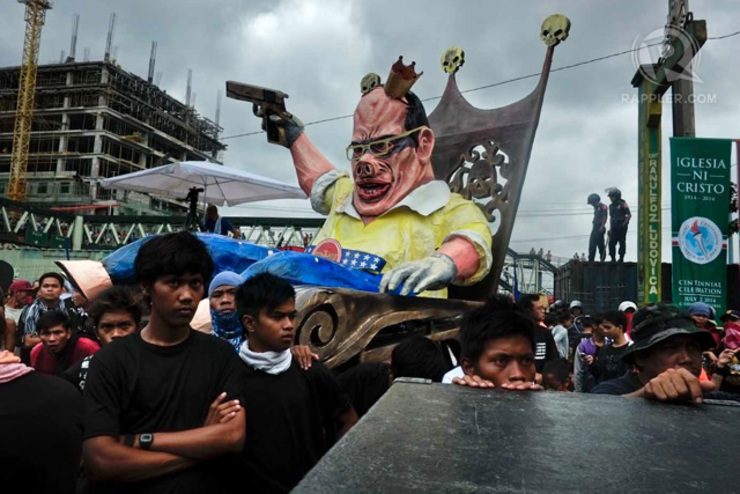
“Dahil sa isyu ng pork barrel, sinimulan namin siyang gawing baboy. Noong una, sa mga maskara lang. Hanggang sa naging pork barrel king siya, at noong napatindi pa ‘yung pag-imbestiga dito sa pork barrel scam, lumabas pa yung DAP (Disbursement Acceleration Program). So lalo pang lumantad ‘yung pagiging baboy niya.”
(We started making his likeness into a pig because of the pork barrel issue. First, as masks. Then, he became a pork barrel king. As the investigation into the pork barrel scam continued, the DAP came to light. All these made him more like a pig.)
From August 2014 up until the rally on International Human Rights in early December, pig-faced images of Aquino remained prevalent.
The shape-shift
Like so many other presidents who came before him, including his mother, Cory, Aquino has been labeled tuta ng Kano or “America’s lap dog”.
When US President Barack Obama came to Manila, it was no surprise that Aquino was lampooned as a dog.
The effigy showed Aquino as a bulldog with spiked leash, pulling a war chariot with Obama onboard, who is dangling a bone labeled USAID for the Philippine president.
“Imahe [ito] ng pagiging tuta, maamo, at nananabik sa kanyang amo. Sumisimbolo sa pagiging tuta niya sa US. Kasi sunud-sunuran si Noynoy sa kung anuman ang sabihin ng Estados Unidos. Kung matatandaan natin ang EDCA (Enhanced Defense Cooperation Agreement), wala namang benepisyo dito ang Pilipinas pero sinangayunan pa rin niya,” explained Silanga.
(This is the image of a puppy: docile, always longing for its master. It symbolizes him as a dog of the US, because Noynoy follows whatever the US says. If we remember EDCA, the Philippines did not benefit from the deal, but he acquiesced.)
“Sumusunod siya doon sa amo niya na magdadala ng digmaan dito sa Southeast Asia. Tapos, para makuha ‘yung USAID, pinapasok niya yung US dito sa Pilipinas kapalit ng kapayapaan,” he added.
(He obeys his master, who will only brings war to Southeast Asia. Then, to get the USAID, he allowed them to gain foothold in the country, in exchange for peace.)
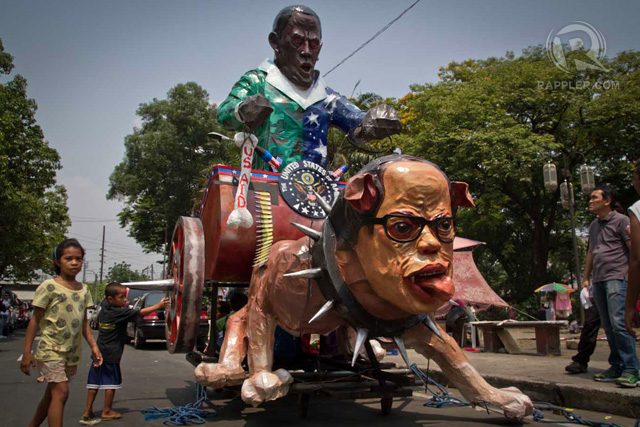
The president as war machine
The shape-shift from pig to dog continued after Aquino was compared to a war machine, a spinoff of Obama’s war chariot effigy.
“Ang konsepto ng chariot ay nanggaling sa Concerned Artists of the Philippines. Pagkatapos in-enhance nang in-enhance, nai-translate. Lumabas ‘yung chariot na warmonger.”
(The concept for the chariot came from the Concerned Artists of the Philippines. We then enhanced the concept until eventually, the idea of chariot as warmonger came about.)
Last Labor Day, another effigy of Aquino was unveiled. It was a war machine with monster claws and a cannon over its shoulder. It was accompanied by a protester clad in Uncle Sam’s costume, with a giant remote control in his hand.
Silanga explains the evolution: “Ibig sabihin, remote control ng US. Kung ano ididikta ng US, susundin niyan. Tuta ‘yan eh. Ibang imahe, na parang papet din, pero mas laruan din. At saka may kanyon. Kung kailangang giyerahin, gigiyerahin, makuha lang ang gusto.”
(It means remote control of the US. Whatever the US dictates, the puppy follows. It’s a different image, much like a puppet, but more like a toy. It also has a cannon. So when they want something, they’ll wage war.)
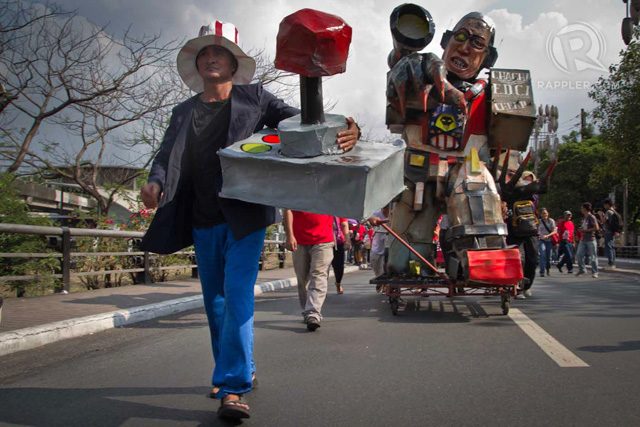
The image of Aquino as warmonger was again seen last December 10, when indigenous peoples from Mindanao marched to Mendiola to protest militarization, and plea for peace.
“Destroyer” is how Silanga called the effigy of Aquino holding a US flag, with machine guns and skulls on his back, and the Malacañang seal on his platform.
“Nagre-represent ng digmaan na nilulungsad laban sa taumbayan,” Silanga said.
(It represents the war waged against the people.)
Aquino as burden to the people
A few days before Holy Week, the People Surge Coalition held a passion protest that saw a Yolanda (Super Typhoon Haiyan) survivor from Samar carrying a giant yellow cross, flanked by a moving effigy of Aquino.
“Pahirap pa sa taumbayan, ‘yung krus, ‘yung kalbaryo na dinudulot ng kawalan ng aksyon ng gobyerno doon sa nangyaring pagsalanta ng Yolanda sa Pilipinas; pag-abandona niya. Ang catchphrase nga niya rito ay, ‘Buhay pa naman kayo, diba?’,” Silanga said.
(A burden to the people, a cross to be carried, the Calvary of the people, the government’s inaction following the calamity brought about by Yolanda to the Philippines. His catchphrase was, “Aren’t you still alive?”)
Soon, “disaster president” became the chant in rallies.
Again, during the International Women’s Day protest, other images of Aquino as burden surfaced. Four women-activists carried on their shoulders, life-size effigies, showing the different smiling faces of Aquino.
“Iba’t ibang hitsura niya. ‘Yung pagngisi niya, pang-asar talaga. Nagpapakasarap siya sa Malacañang habang pinahihirapan ‘yung taumbayan.”
(Different smirking faces. It’s offensive. He’s enjoying his life in Malacañang while being a burden to the people.)
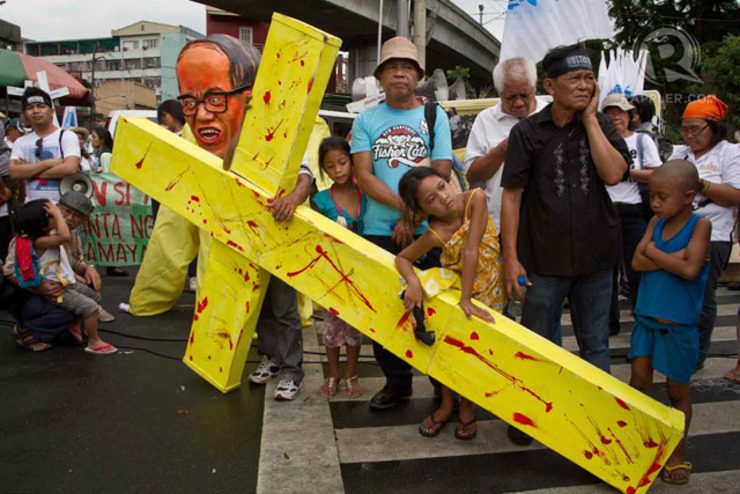
Silaga said the urban poor community was among those heaviest hit in 2014, with the demolitions the government carried out against informal settlers.
“Sa panahon kasi ni Noynoy, masasabi natin na matindi ‘yung pag-atake niya sa urban poor community. At wala talaga siyang patumangging i-demolish ito para sa Public-Private Partnership Program,” he claimed.
(During Noynoy’s term, we can say that the urban poor community suffered a lot. The demolitions were carried out for his Public-Private Partnership Program.)
Among those demolitions was the road-widening project at the Manila North Harbor. The headquarters of the militant organization Kadamay was among the demolished shanties. Silanga was working on a mural for his comrades at Kadamay.
“Nagpapagawa sila ng mural na gagawing backdrop sa community. Hindi ko na nabalikan. Na-demolish na.”
(They wanted me to work on a mural as backdrop for the community. I never got back to it. It was demolished.)
The last effigy that Silanga worked on was recently used by Migrante International during the International Migrants’ Day. It portrayed Aquino in stereotypical haciendero garb, clad in vest and boots—an allusion to his landlord status. But he’s also standing on balikbayan boxes, with a pistol in his hand, and a turnkey embedded on his ribs.
“May hawak siyang kadena na nakakonekta sa taumbayan. Kadena ng kahirapan at kawalan ng trabaho, at iba pang pang-ekonomikong dahilan kung bakit umaalis ang mga tao, napipilitang mangibang-bansa, at doon nagpapakasakit,” Silanga elaborates.
(He’s holding a chain shackling people. These are the chains of poverty, joblessness, and other economic reasons, which force Filipinos to leave the country, work abroad, and suffer overseas.)
During the rally, the protesters broke free from their chains, put the shackles on the image of Aquino, then trashed his effigy.
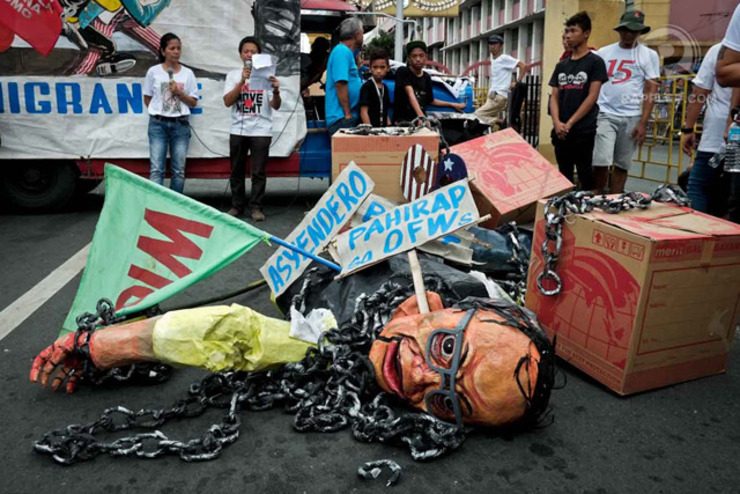
“Siyempre, kung tulong sa paglabas sa isyu, ‘yung ganoong kalaking imahe, ‘pag nakita ng taumbayan, napanood sa TV o nakita sa dyaryo, kahit hindi pa nakasulat ‘yung isyu, pag nakita nila ‘yung imahe, mauunawaan nila kung bakit ginawa ‘yung effigy na ‘yon,” Silanga claimed.
(To bring an issue to light, when people see such a huge image, whether they watch it on TV or see it on newspapers, even without textual context, once they see the image, they’d understand why that certain effigy was made.) – Rappler.com
Add a comment
How does this make you feel?
There are no comments yet. Add your comment to start the conversation.